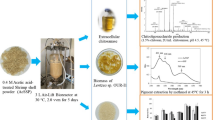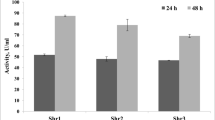Abstract
In this study, shrimp shell powder, prepared by treating shrimp-processing waste by boiling and crushing, was used as a substrate for isolation of chitinase-producing microorganism. These organisms may have an important economic role in the biological control of rice and other fungal pathogens. Two hundred strains of bacteria with the ability to degrade chitin from shrimp shell waste were isolated from paddy soil, and of these, 40 strains showed chitinase activity in a solid state cultivation. One of the most potent isolates (strain R 176) was identified as Bacillus thuringiensis. Identification was carried out using morphological and biochemical properties along with 16S rRNA sequence analysis. This strain was able to produce high levels of extracellular chitinase in solid media containing shrimp shells as sole carbon source [1.36 U/g initial dry substrate (IDS)], which was 0.36-fold higher than the productivity in a liquid culture with colloidal chitin. The effects of medium composition and physical parameters on chitinase production by this organism were studied. The optimal medium contained shrimp shell mixed with rice straw in 1:1 ratio added with ball-milled chitin 0.5 % (w/v) and ammonium sulfate 0.5 % (w/v). The highest enzyme production (3.86 U/g IDS) by B. thuringiensis R 176 was obtained at pH 7, 37 °C after 14 days growth. With respect to the high amount of chitinase production by this strain in a simple medium, this strain could be a suitable candidate for the production of chitinase from chitinous solid substrates, and further investigations into its structure and characteristics are merited.





Similar content being viewed by others
References
Akagi K, Watanabe J, Hara M, Kezuka Y, Chikaishi E, Yamaguchi T, Akutsu H, Nonaka T, Watanabe T, Ikegami T (2006) Identification of the substrate interaction region of the chitin-binding domain of Streptomyces griseus chitinase C. J Biochem (Tokyo) 139:483–493
Barboza-Corona JE, Velazquez-Robledo R, Bautista-Justo M, Gomez-Ramirez M, Cruz-Camarillo R, Ibarra JE (1999) Selection of chitinolytic strains of Bacillus thuringiensis. Biotechnol Lett 21:1125–1129
Berger LR, Reynolds DM (1958) The chitinase system of a strain of Streptomyces griseus. Biochem Biophys Acta 29:522–534
Chang WT, Chen YC, Jao CL (2007) Antifungal activity and enhancement of plant growth by Bacillus cereus grown on shellfish chitin wastes. Bioresour Technol 98:1224–1230
de la Vega LM, Barboza-Corana JE, Aguilar-Uscanga MG, Ramirez-Lepe M (2006) Purification and characterization of an exochitinase from Bacillus thuringiensis sunsp ailawai and its action against phytopathogenic fungi. Can J Microbiol 52:651–657
Felse PA, Panda T (2000) Submerged culture production of chitinase by Trichoderma harzianum in stirred tank bioreactors-the influence of agitator speed. Biochem Eng 4:115–120
Fenice M, Gooday GW (2006) Mycoparasitic actions against fungi and oomycetes by a strain (CCFEE 5003) of the fungus Lecanicillium muscarium isolated in continental Antarctica. Ann Microbiol 56:1–6
Hackman RH (1962) Studies on chitin V: the action of mineral acids on chitin. Aust J Biol Sci 15:526–537
Holt JG, Krieg PHA, Seath JT, Willums ST (1994) Bergey′s manual of determinative bacteriology, 9th edn. Willium & Wilkins, Baltimore
Huang CJ, Wang TK, Chung SC, Chen CY (2005) Identification of an antifungal chitinase from a potential biocontrol agent, Bacillus cereus 28–9. J Biochem Mol Biol Sci 38:82–88
Jami al Ahmadi K, Tabatabaei YM, Fathi NM, Shahcerdi AR, Faramarzi MA, Zarrini G, Behravan J (2008) Optimization of medium and cultivation conditions for chitinase production by newly isolated: Aeromonas sp. Biotechnology 7:266–272
Leschine S, Canale-Parola E (1983) Mesophilic cellulolytic clostridia from freshwater environments. Appl Environ Microbiol 46:728–737
Liu M, Cai QX, Liu HZ, Zhang BH, Yan JP, Yuan ZM (2002) Chitinolytic activities in Bacillus thuringiensis and their synergistic effects on larvicidal activity. Appl Microbiol 93:374–379
Mabuchi N, Hashizumi I, Araki Y (2000) Characterization of chitinases excreted by Bacillus cereus CH. Can J Microbiol 46:370–375
Marchesi JR, Sato T, Weightman AJ, Martin TA, Fry JC, Hiom SJ, Dymock D, Wade WG (1998) Design and evaluation of useful bacterium-specific PCR primers that amplify genes coding for bacteria 16S rRNA. Appl Environ Microbiol 64:795–799
Miller GL (1959) Using of dinitrosalicylic acid reagent for determination of reducing sugars. Anal Chem 8:426–428
Muzzarelli RAA, Boudrant J, Meyer D, Manno N, DeMarchis M, Paoletti MG (2012) Current views on fungal chitin/chitosan, human chitinases, food preservation, glucans, pectins and inulin: a tribute to Henri Braconnot, precursor of the carbohydrate polymers science, on the chitin bicentennial. Carbohydr Polym 87:995–1012
Narayana KJP, Vijaualakshimi M (2009) Chitinase production by Streptomyces sp. ANU 6277. Braz J Microbiol 4:36–40
Nawani NN, Kapadnis BP (2003) Chitin degrading potential of bacteria from extreme and moderate environment. Indian J Exp Biol 41:248–254
Rattanakit NA, Plikomol A, Yano S, Wakayama M, Tachiki T (2002) Utilization of shrimp shellfish waste as a substrate for solid-state cultivation of Aspergillus sp. S1-13: evaluation of a culture based on chitinase formation which is necessary for chitin-assimilation. J Biosci Bioeng 93:550–559
Roberts WK, Selitrennikoff CP (1988) Plant and bacterial chitinases differ in antifungal activity. J Gen Microbiol 134:169–176
Shanmugaiah V, Mathivanan N, Balasubramanian N, Manoharan PT (2008) Optimization of culture conditions for production of chitinase by Bacillus laterosporous MML2270 isolated from rice rhizosphere soil. Afr J Biotechnol 7:2562–2568
Sharaf EF (2005) A potent chitinolytic activity of Alternaria alternate isolated from Egyptian black sand. Pol J Microbiol 54:145–151
Sokal RP, Rohlf FJ (1995) Biometry: the principle and practice of statistics in biological research, 3rd edn. Willy Freeman and company, New Willy Freeman and Company, New York
Sudhakar P, Nagarajan P (2010) Production of chitinase by solid state fermentation from rice bran. Int J Environ Sci Dev 1:435–441
Van Overbeek LS, van Veen JA, van Elsas JD (1997) Induced reporter gene activity, enhanced stress resistance, and competitive ability of a genetically modified Pseudomonas fluorescens strain released into a field plot planted with wheat. Appl Environ Microbiol 63:1965–1973
Waldeck J, Daum G, Bisping B, Meinhardt F (2006) Isolation and molecular characterization of chitinase deficient Bacillus licheniformis strain capable of deproteinization of shrimp shell waste to obtain highly viscous chitin. Appl Environ Microbiol 72:7879–7885
Wang SL, Lin TY, Yen YH, Liao HF, Chen YJ (2006) Bioconversion of shellfish chitin wastes for the production of Bacillus subtilis W-118 chitinase. Carbohydr Res 341:2507–2515
Wiwat C, Thaithanun S, Pantowatana S, Bhumiratana A (2000) Toxicity of chitinase producing Bacillus thuringiensis sp. Kurstaki HD-1(G) toward Plutella xylostella. J Invertebr Pathol 76:270–277
Zhu V, Jieru P, Zunzhi P, Xiong G (2008) Isolation and characterization of a chitinase gene from entomopathogenic fungus Verticillium lecanii. Braz J Microbiol 39:314–320
Acknowledgments
We would like to extend our appreciation to the Japan Society for the Promotion of Science and National Council Thailand Core University Program on Microbial Resources, for providing us with some chemicals via Ritsumeikan University. We thank Mr. Keekan Hailey Kennedy, Chiang Mai University, Thailand, for helping edit the manuscript.
Author information
Authors and Affiliations
Corresponding author
Rights and permissions
About this article
Cite this article
Chaiharn, M., Lumyong, S., Hasan, N. et al. Solid-state cultivation of Bacillus thuringiensis R 176 with shrimp shells and rice straw as a substrate for chitinase production. Ann Microbiol 63, 443–450 (2013). https://doi.org/10.1007/s13213-012-0488-6
Received:
Accepted:
Published:
Issue Date:
DOI: https://doi.org/10.1007/s13213-012-0488-6




